Cost Accounting Analysis for ABC and PQR
VerifiedAdded on 2020/04/21
|13
|1898
|131
AI Summary
This assignment delves into cost accounting concepts by analyzing the scenarios of two companies, ABC and PQR. It explores topics like make-or-buy decisions, traditional costing methods, and variance analysis. Students are tasked with calculating production costs, comparing options for manufacturing parts, and understanding the implications of different costing approaches.
Contribute Materials
Your contribution can guide someone’s learning journey. Share your
documents today.
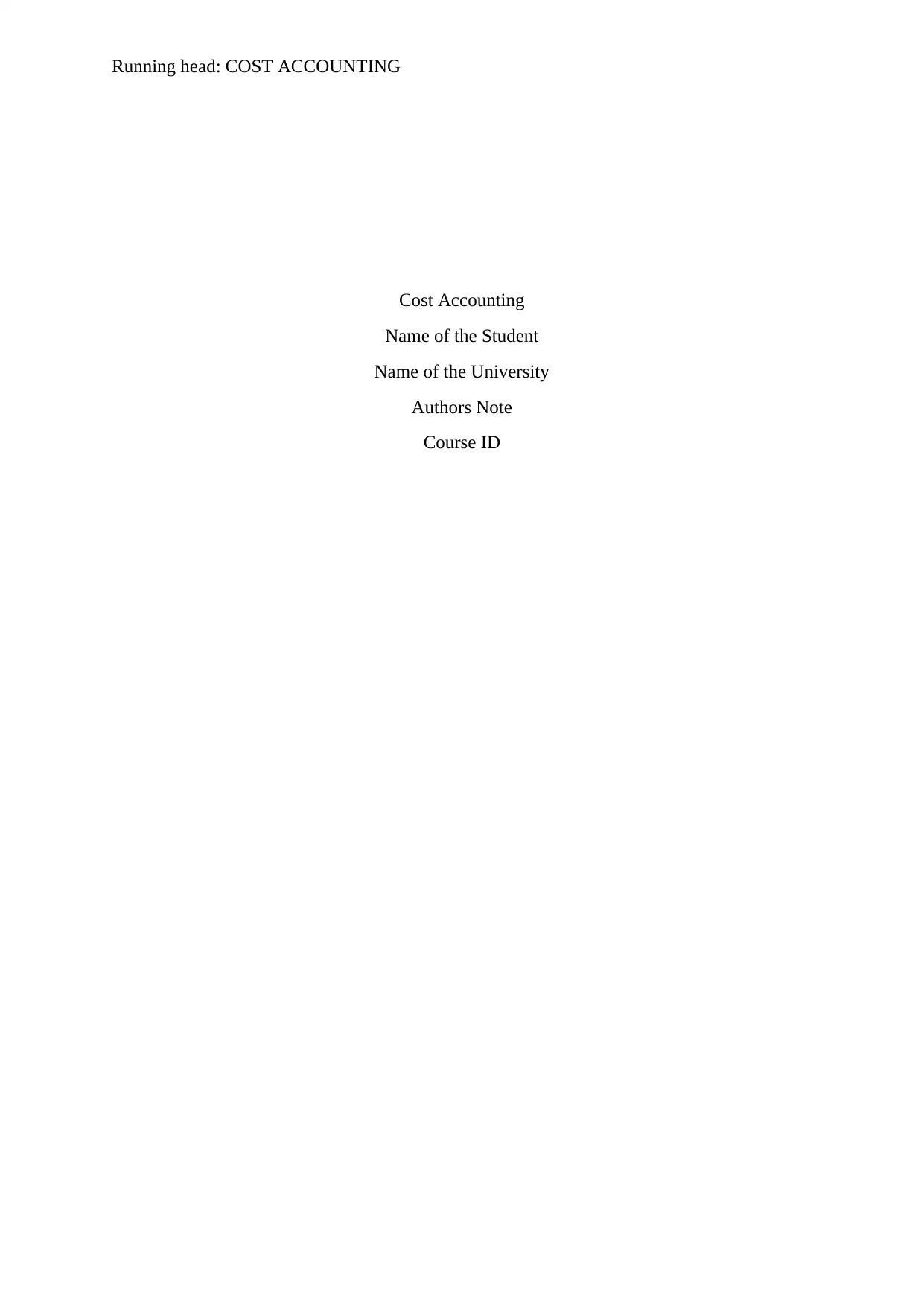
Running head: COST ACCOUNTING
Cost Accounting
Name of the Student
Name of the University
Authors Note
Course ID
Cost Accounting
Name of the Student
Name of the University
Authors Note
Course ID
Secure Best Marks with AI Grader
Need help grading? Try our AI Grader for instant feedback on your assignments.
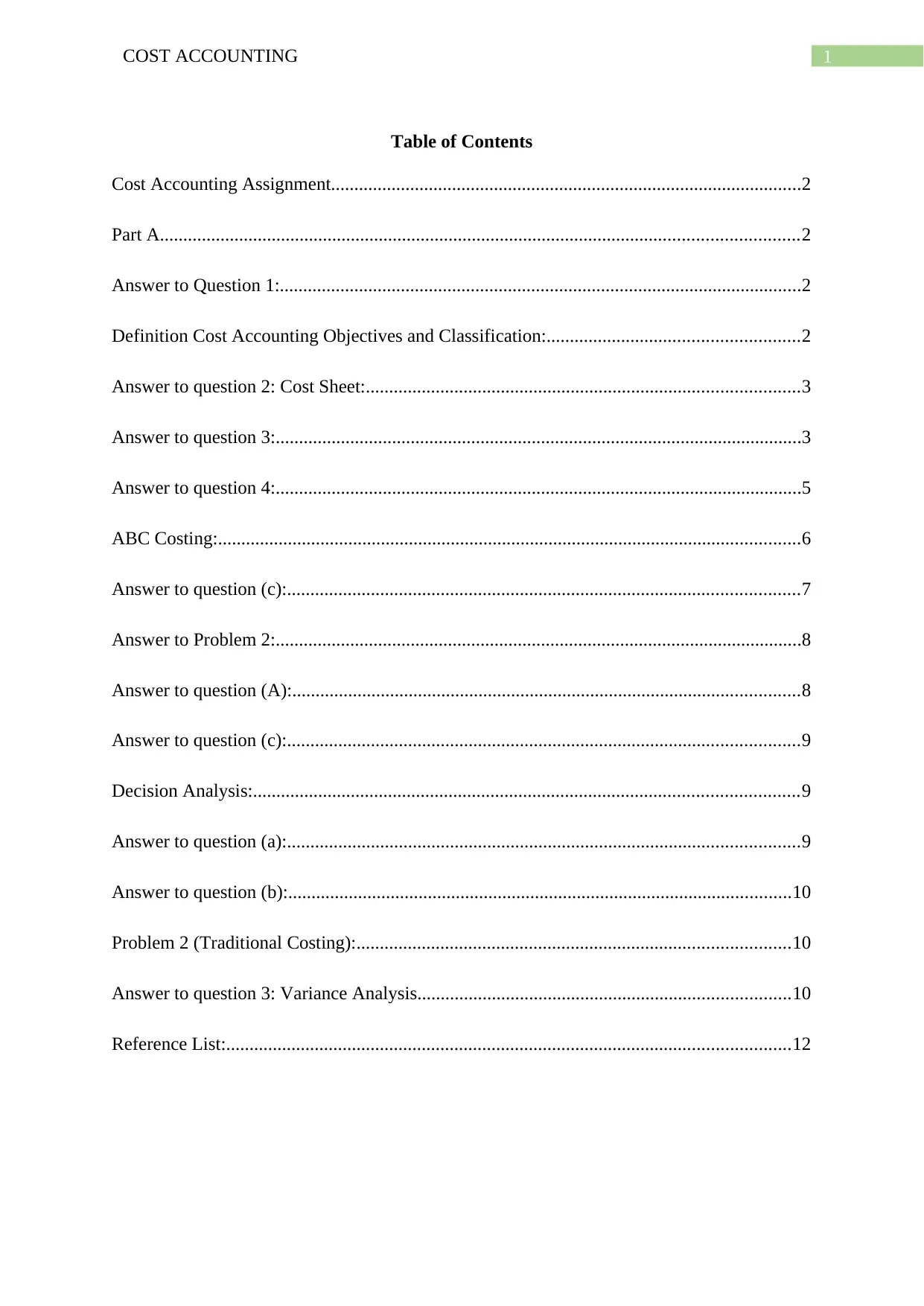
1COST ACCOUNTING
Table of Contents
Cost Accounting Assignment.....................................................................................................2
Part A.........................................................................................................................................2
Answer to Question 1:................................................................................................................2
Definition Cost Accounting Objectives and Classification:......................................................2
Answer to question 2: Cost Sheet:.............................................................................................3
Answer to question 3:.................................................................................................................3
Answer to question 4:.................................................................................................................5
ABC Costing:.............................................................................................................................6
Answer to question (c):..............................................................................................................7
Answer to Problem 2:.................................................................................................................8
Answer to question (A):.............................................................................................................8
Answer to question (c):..............................................................................................................9
Decision Analysis:.....................................................................................................................9
Answer to question (a):..............................................................................................................9
Answer to question (b):............................................................................................................10
Problem 2 (Traditional Costing):.............................................................................................10
Answer to question 3: Variance Analysis................................................................................10
Reference List:.........................................................................................................................12
Table of Contents
Cost Accounting Assignment.....................................................................................................2
Part A.........................................................................................................................................2
Answer to Question 1:................................................................................................................2
Definition Cost Accounting Objectives and Classification:......................................................2
Answer to question 2: Cost Sheet:.............................................................................................3
Answer to question 3:.................................................................................................................3
Answer to question 4:.................................................................................................................5
ABC Costing:.............................................................................................................................6
Answer to question (c):..............................................................................................................7
Answer to Problem 2:.................................................................................................................8
Answer to question (A):.............................................................................................................8
Answer to question (c):..............................................................................................................9
Decision Analysis:.....................................................................................................................9
Answer to question (a):..............................................................................................................9
Answer to question (b):............................................................................................................10
Problem 2 (Traditional Costing):.............................................................................................10
Answer to question 3: Variance Analysis................................................................................10
Reference List:.........................................................................................................................12
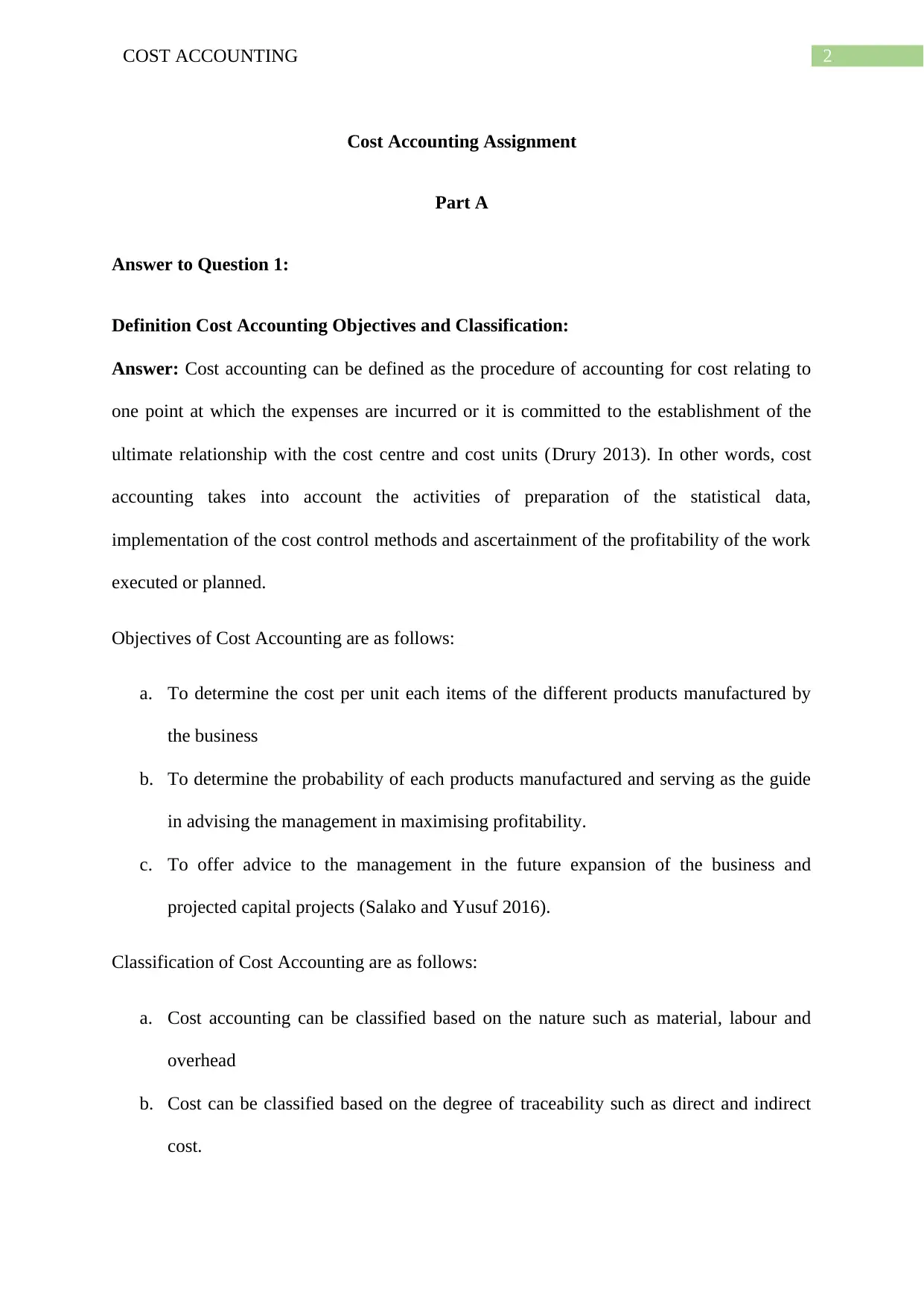
2COST ACCOUNTING
Cost Accounting Assignment
Part A
Answer to Question 1:
Definition Cost Accounting Objectives and Classification:
Answer: Cost accounting can be defined as the procedure of accounting for cost relating to
one point at which the expenses are incurred or it is committed to the establishment of the
ultimate relationship with the cost centre and cost units (Drury 2013). In other words, cost
accounting takes into account the activities of preparation of the statistical data,
implementation of the cost control methods and ascertainment of the profitability of the work
executed or planned.
Objectives of Cost Accounting are as follows:
a. To determine the cost per unit each items of the different products manufactured by
the business
b. To determine the probability of each products manufactured and serving as the guide
in advising the management in maximising profitability.
c. To offer advice to the management in the future expansion of the business and
projected capital projects (Salako and Yusuf 2016).
Classification of Cost Accounting are as follows:
a. Cost accounting can be classified based on the nature such as material, labour and
overhead
b. Cost can be classified based on the degree of traceability such as direct and indirect
cost.
Cost Accounting Assignment
Part A
Answer to Question 1:
Definition Cost Accounting Objectives and Classification:
Answer: Cost accounting can be defined as the procedure of accounting for cost relating to
one point at which the expenses are incurred or it is committed to the establishment of the
ultimate relationship with the cost centre and cost units (Drury 2013). In other words, cost
accounting takes into account the activities of preparation of the statistical data,
implementation of the cost control methods and ascertainment of the profitability of the work
executed or planned.
Objectives of Cost Accounting are as follows:
a. To determine the cost per unit each items of the different products manufactured by
the business
b. To determine the probability of each products manufactured and serving as the guide
in advising the management in maximising profitability.
c. To offer advice to the management in the future expansion of the business and
projected capital projects (Salako and Yusuf 2016).
Classification of Cost Accounting are as follows:
a. Cost accounting can be classified based on the nature such as material, labour and
overhead
b. Cost can be classified based on the degree of traceability such as direct and indirect
cost.
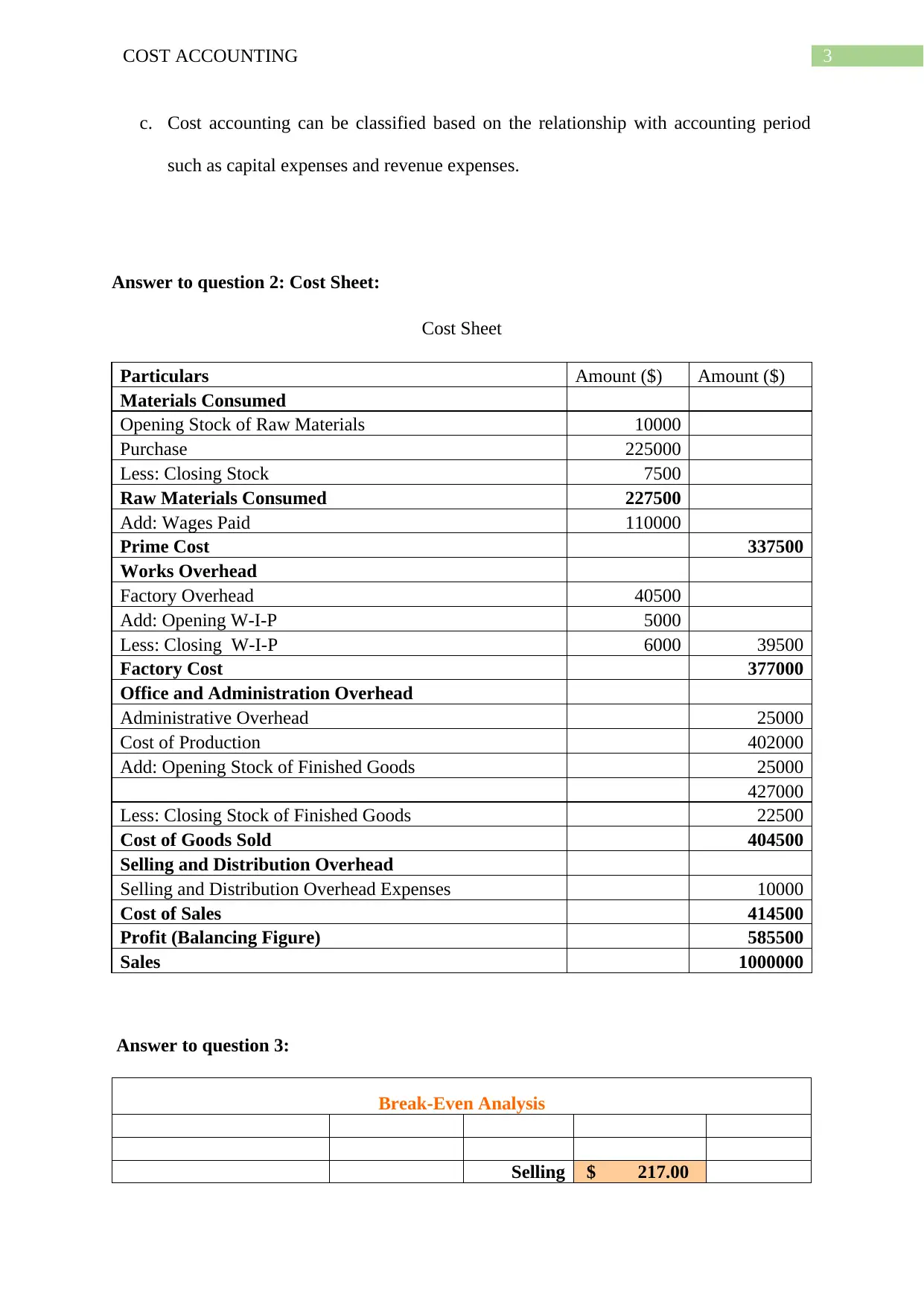
3COST ACCOUNTING
c. Cost accounting can be classified based on the relationship with accounting period
such as capital expenses and revenue expenses.
Answer to question 2: Cost Sheet:
Cost Sheet
Particulars Amount ($) Amount ($)
Materials Consumed
Opening Stock of Raw Materials 10000
Purchase 225000
Less: Closing Stock 7500
Raw Materials Consumed 227500
Add: Wages Paid 110000
Prime Cost 337500
Works Overhead
Factory Overhead 40500
Add: Opening W-I-P 5000
Less: Closing W-I-P 6000 39500
Factory Cost 377000
Office and Administration Overhead
Administrative Overhead 25000
Cost of Production 402000
Add: Opening Stock of Finished Goods 25000
427000
Less: Closing Stock of Finished Goods 22500
Cost of Goods Sold 404500
Selling and Distribution Overhead
Selling and Distribution Overhead Expenses 10000
Cost of Sales 414500
Profit (Balancing Figure) 585500
Sales 1000000
Answer to question 3:
Break-Even Analysis
Selling $ 217.00
c. Cost accounting can be classified based on the relationship with accounting period
such as capital expenses and revenue expenses.
Answer to question 2: Cost Sheet:
Cost Sheet
Particulars Amount ($) Amount ($)
Materials Consumed
Opening Stock of Raw Materials 10000
Purchase 225000
Less: Closing Stock 7500
Raw Materials Consumed 227500
Add: Wages Paid 110000
Prime Cost 337500
Works Overhead
Factory Overhead 40500
Add: Opening W-I-P 5000
Less: Closing W-I-P 6000 39500
Factory Cost 377000
Office and Administration Overhead
Administrative Overhead 25000
Cost of Production 402000
Add: Opening Stock of Finished Goods 25000
427000
Less: Closing Stock of Finished Goods 22500
Cost of Goods Sold 404500
Selling and Distribution Overhead
Selling and Distribution Overhead Expenses 10000
Cost of Sales 414500
Profit (Balancing Figure) 585500
Sales 1000000
Answer to question 3:
Break-Even Analysis
Selling $ 217.00
Secure Best Marks with AI Grader
Need help grading? Try our AI Grader for instant feedback on your assignments.
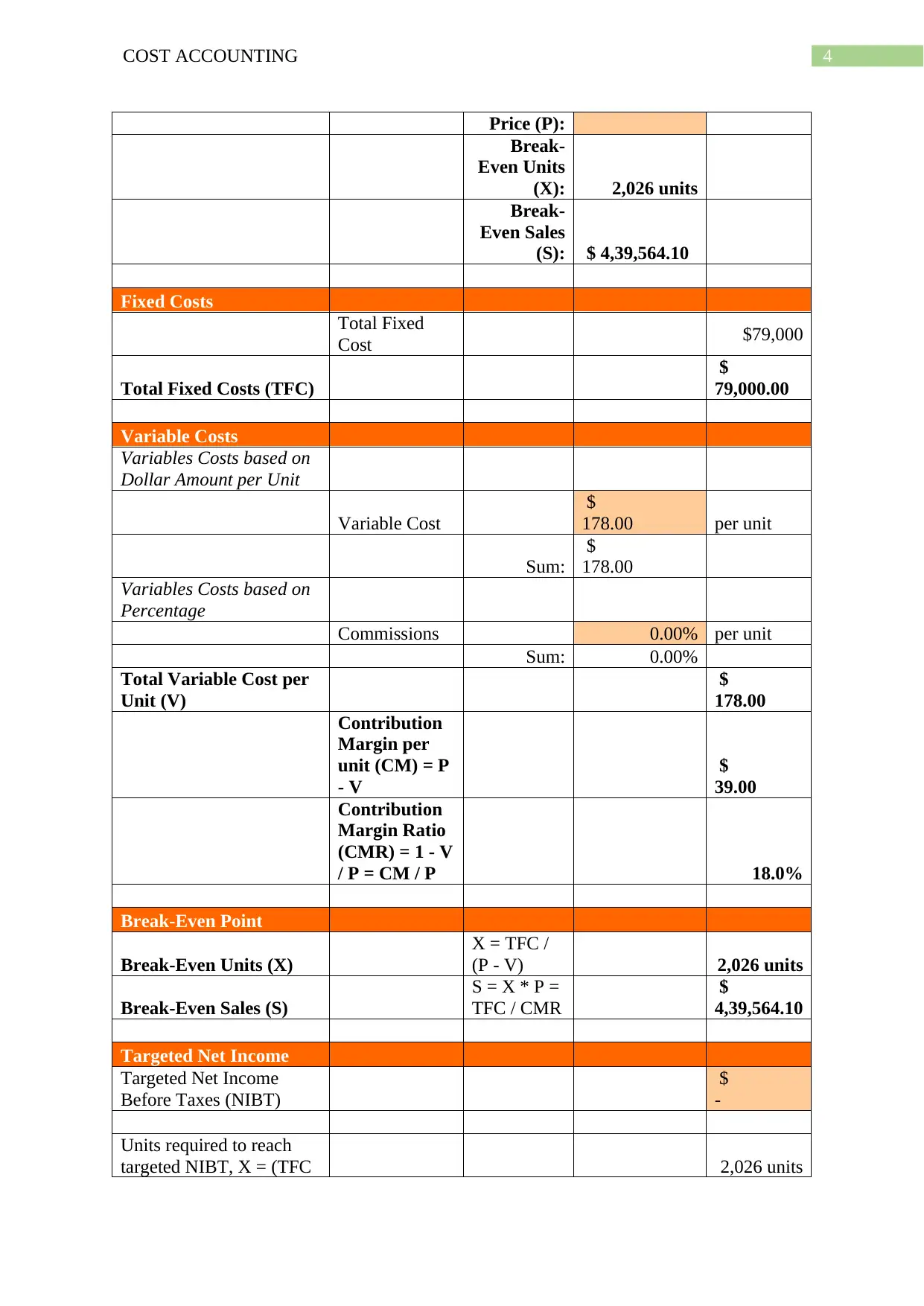
4COST ACCOUNTING
Price (P):
Break-
Even Units
(X): 2,026 units
Break-
Even Sales
(S): $ 4,39,564.10
[42]
Fixed Costs
Total Fixed
Cost $79,000
Total Fixed Costs (TFC)
$
79,000.00
Variable Costs
Variables Costs based on
Dollar Amount per Unit
Variable Cost
$
178.00 per unit
Sum:
$
178.00
Variables Costs based on
Percentage
Commissions 0.00% per unit
Sum: 0.00%
Total Variable Cost per
Unit (V)
$
178.00
Contribution
Margin per
unit (CM) = P
- V
$
39.00
Contribution
Margin Ratio
(CMR) = 1 - V
/ P = CM / P 18.0%
Break-Even Point
Break-Even Units (X)
X = TFC /
(P - V) 2,026 units
Break-Even Sales (S)
S = X * P =
TFC / CMR
$
4,39,564.10
Targeted Net Income
Targeted Net Income
Before Taxes (NIBT)
$
-
Units required to reach
targeted NIBT, X = (TFC 2,026 units
Price (P):
Break-
Even Units
(X): 2,026 units
Break-
Even Sales
(S): $ 4,39,564.10
[42]
Fixed Costs
Total Fixed
Cost $79,000
Total Fixed Costs (TFC)
$
79,000.00
Variable Costs
Variables Costs based on
Dollar Amount per Unit
Variable Cost
$
178.00 per unit
Sum:
$
178.00
Variables Costs based on
Percentage
Commissions 0.00% per unit
Sum: 0.00%
Total Variable Cost per
Unit (V)
$
178.00
Contribution
Margin per
unit (CM) = P
- V
$
39.00
Contribution
Margin Ratio
(CMR) = 1 - V
/ P = CM / P 18.0%
Break-Even Point
Break-Even Units (X)
X = TFC /
(P - V) 2,026 units
Break-Even Sales (S)
S = X * P =
TFC / CMR
$
4,39,564.10
Targeted Net Income
Targeted Net Income
Before Taxes (NIBT)
$
-
Units required to reach
targeted NIBT, X = (TFC 2,026 units
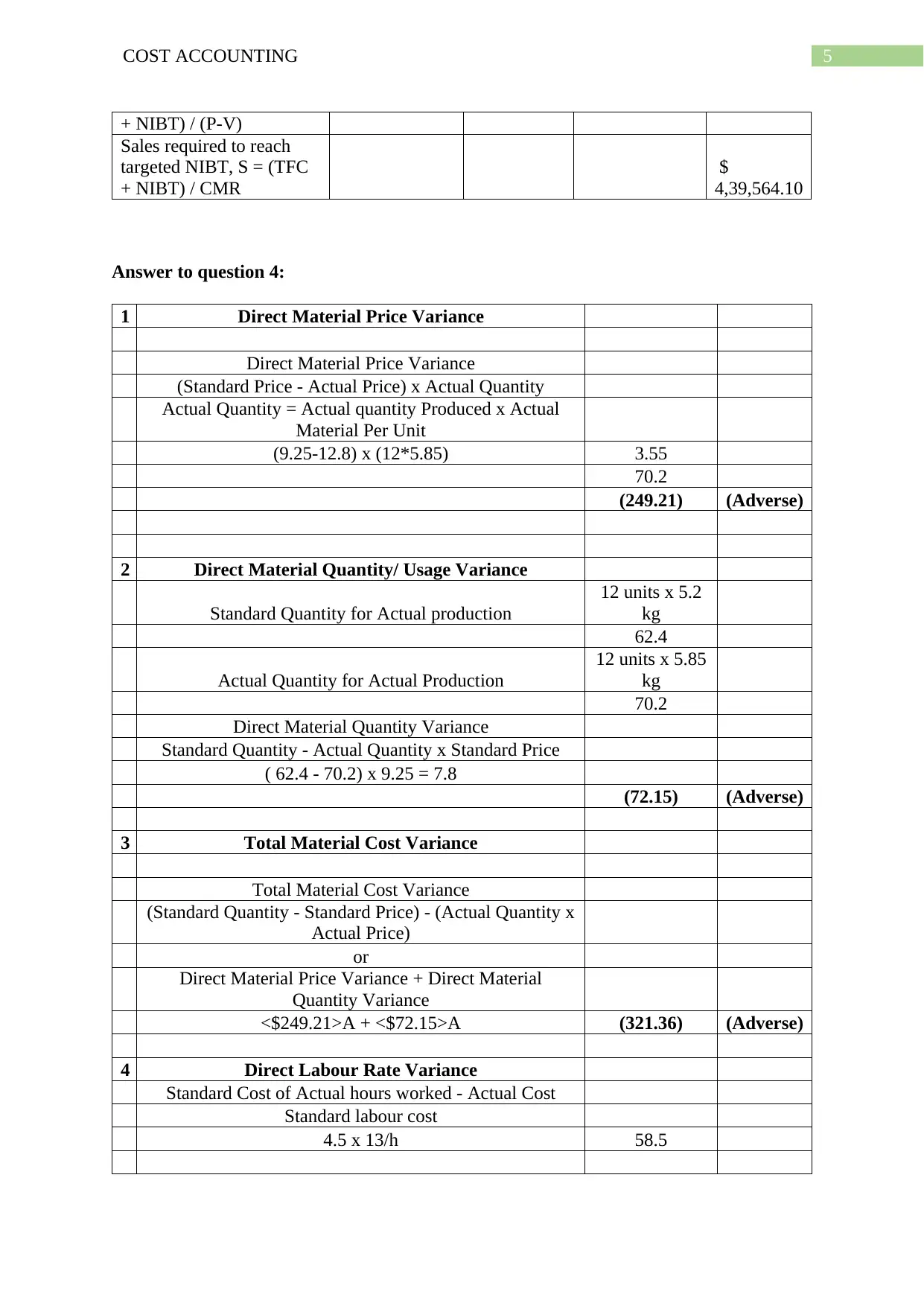
5COST ACCOUNTING
+ NIBT) / (P-V)
Sales required to reach
targeted NIBT, S = (TFC
+ NIBT) / CMR
$
4,39,564.10
Answer to question 4:
1 Direct Material Price Variance
Direct Material Price Variance
(Standard Price - Actual Price) x Actual Quantity
Actual Quantity = Actual quantity Produced x Actual
Material Per Unit
(9.25-12.8) x (12*5.85) 3.55
70.2
(249.21) (Adverse)
2 Direct Material Quantity/ Usage Variance
Standard Quantity for Actual production
12 units x 5.2
kg
62.4
Actual Quantity for Actual Production
12 units x 5.85
kg
70.2
Direct Material Quantity Variance
Standard Quantity - Actual Quantity x Standard Price
( 62.4 - 70.2) x 9.25 = 7.8
(72.15) (Adverse)
3 Total Material Cost Variance
Total Material Cost Variance
(Standard Quantity - Standard Price) - (Actual Quantity x
Actual Price)
or
Direct Material Price Variance + Direct Material
Quantity Variance
<$249.21>A + <$72.15>A (321.36) (Adverse)
4 Direct Labour Rate Variance
Standard Cost of Actual hours worked - Actual Cost
Standard labour cost
4.5 x 13/h 58.5
+ NIBT) / (P-V)
Sales required to reach
targeted NIBT, S = (TFC
+ NIBT) / CMR
$
4,39,564.10
Answer to question 4:
1 Direct Material Price Variance
Direct Material Price Variance
(Standard Price - Actual Price) x Actual Quantity
Actual Quantity = Actual quantity Produced x Actual
Material Per Unit
(9.25-12.8) x (12*5.85) 3.55
70.2
(249.21) (Adverse)
2 Direct Material Quantity/ Usage Variance
Standard Quantity for Actual production
12 units x 5.2
kg
62.4
Actual Quantity for Actual Production
12 units x 5.85
kg
70.2
Direct Material Quantity Variance
Standard Quantity - Actual Quantity x Standard Price
( 62.4 - 70.2) x 9.25 = 7.8
(72.15) (Adverse)
3 Total Material Cost Variance
Total Material Cost Variance
(Standard Quantity - Standard Price) - (Actual Quantity x
Actual Price)
or
Direct Material Price Variance + Direct Material
Quantity Variance
<$249.21>A + <$72.15>A (321.36) (Adverse)
4 Direct Labour Rate Variance
Standard Cost of Actual hours worked - Actual Cost
Standard labour cost
4.5 x 13/h 58.5
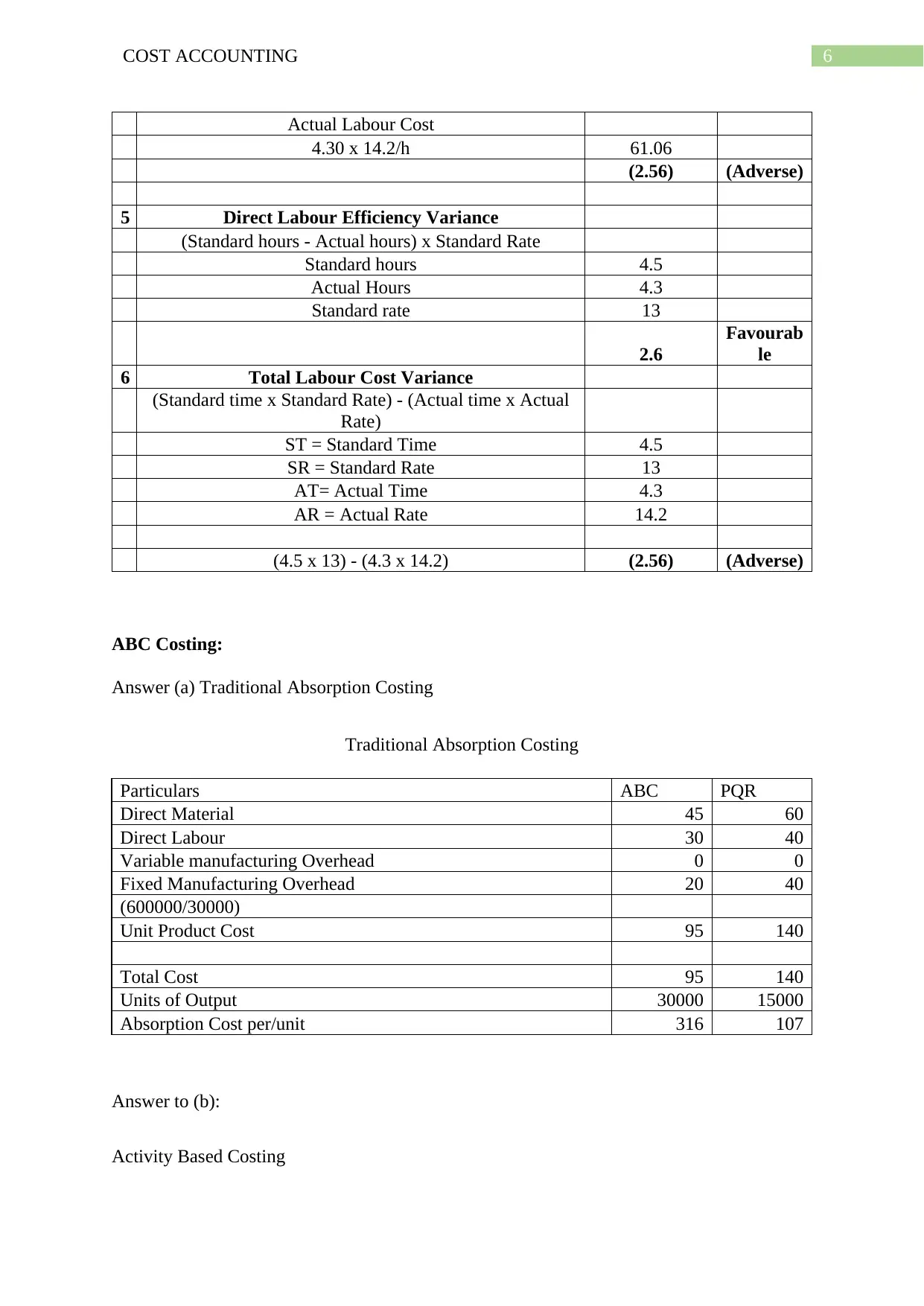
6COST ACCOUNTING
Actual Labour Cost
4.30 x 14.2/h 61.06
(2.56) (Adverse)
5 Direct Labour Efficiency Variance
(Standard hours - Actual hours) x Standard Rate
Standard hours 4.5
Actual Hours 4.3
Standard rate 13
2.6
Favourab
le
6 Total Labour Cost Variance
(Standard time x Standard Rate) - (Actual time x Actual
Rate)
ST = Standard Time 4.5
SR = Standard Rate 13
AT= Actual Time 4.3
AR = Actual Rate 14.2
(4.5 x 13) - (4.3 x 14.2) (2.56) (Adverse)
ABC Costing:
Answer (a) Traditional Absorption Costing
Traditional Absorption Costing
Particulars ABC PQR
Direct Material 45 60
Direct Labour 30 40
Variable manufacturing Overhead 0 0
Fixed Manufacturing Overhead 20 40
(600000/30000)
Unit Product Cost 95 140
Total Cost 95 140
Units of Output 30000 15000
Absorption Cost per/unit 316 107
Answer to (b):
Activity Based Costing
Actual Labour Cost
4.30 x 14.2/h 61.06
(2.56) (Adverse)
5 Direct Labour Efficiency Variance
(Standard hours - Actual hours) x Standard Rate
Standard hours 4.5
Actual Hours 4.3
Standard rate 13
2.6
Favourab
le
6 Total Labour Cost Variance
(Standard time x Standard Rate) - (Actual time x Actual
Rate)
ST = Standard Time 4.5
SR = Standard Rate 13
AT= Actual Time 4.3
AR = Actual Rate 14.2
(4.5 x 13) - (4.3 x 14.2) (2.56) (Adverse)
ABC Costing:
Answer (a) Traditional Absorption Costing
Traditional Absorption Costing
Particulars ABC PQR
Direct Material 45 60
Direct Labour 30 40
Variable manufacturing Overhead 0 0
Fixed Manufacturing Overhead 20 40
(600000/30000)
Unit Product Cost 95 140
Total Cost 95 140
Units of Output 30000 15000
Absorption Cost per/unit 316 107
Answer to (b):
Activity Based Costing
Paraphrase This Document
Need a fresh take? Get an instant paraphrase of this document with our AI Paraphraser
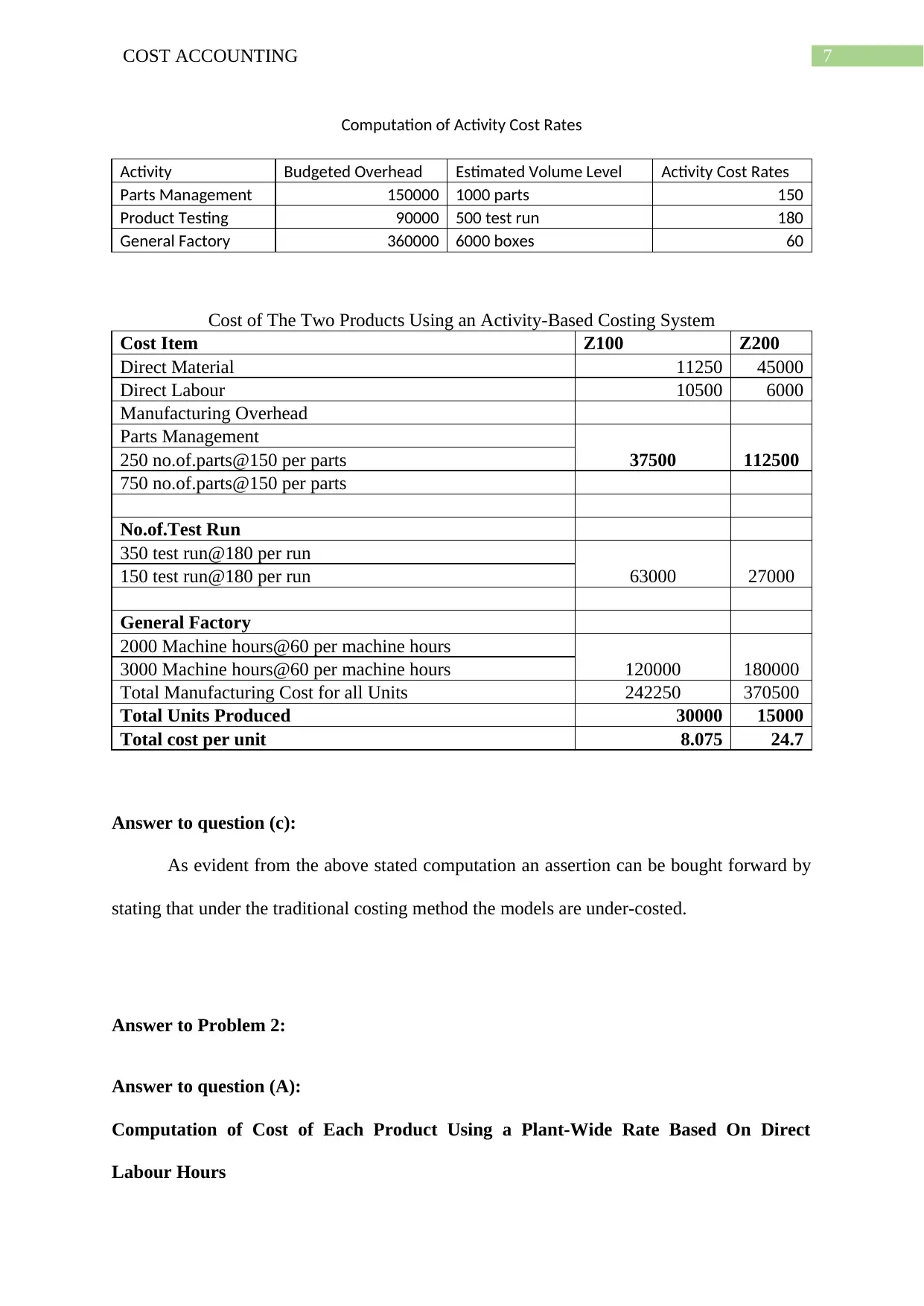
7COST ACCOUNTING
Computation of Activity Cost Rates
Activity Budgeted Overhead Estimated Volume Level Activity Cost Rates
Parts Management 150000 1000 parts 150
Product Testing 90000 500 test run 180
General Factory 360000 6000 boxes 60
Cost of The Two Products Using an Activity-Based Costing System
Cost Item Z100 Z200
Direct Material 11250 45000
Direct Labour 10500 6000
Manufacturing Overhead
Parts Management
37500 112500250 no.of.parts@150 per parts
750 no.of.parts@150 per parts
No.of.Test Run
350 test run@180 per run
63000 27000150 test run@180 per run
General Factory
2000 Machine hours@60 per machine hours
120000 1800003000 Machine hours@60 per machine hours
Total Manufacturing Cost for all Units 242250 370500
Total Units Produced 30000 15000
Total cost per unit 8.075 24.7
Answer to question (c):
As evident from the above stated computation an assertion can be bought forward by
stating that under the traditional costing method the models are under-costed.
Answer to Problem 2:
Answer to question (A):
Computation of Cost of Each Product Using a Plant-Wide Rate Based On Direct
Labour Hours
Computation of Activity Cost Rates
Activity Budgeted Overhead Estimated Volume Level Activity Cost Rates
Parts Management 150000 1000 parts 150
Product Testing 90000 500 test run 180
General Factory 360000 6000 boxes 60
Cost of The Two Products Using an Activity-Based Costing System
Cost Item Z100 Z200
Direct Material 11250 45000
Direct Labour 10500 6000
Manufacturing Overhead
Parts Management
37500 112500250 no.of.parts@150 per parts
750 no.of.parts@150 per parts
No.of.Test Run
350 test run@180 per run
63000 27000150 test run@180 per run
General Factory
2000 Machine hours@60 per machine hours
120000 1800003000 Machine hours@60 per machine hours
Total Manufacturing Cost for all Units 242250 370500
Total Units Produced 30000 15000
Total cost per unit 8.075 24.7
Answer to question (c):
As evident from the above stated computation an assertion can be bought forward by
stating that under the traditional costing method the models are under-costed.
Answer to Problem 2:
Answer to question (A):
Computation of Cost of Each Product Using a Plant-Wide Rate Based On Direct
Labour Hours
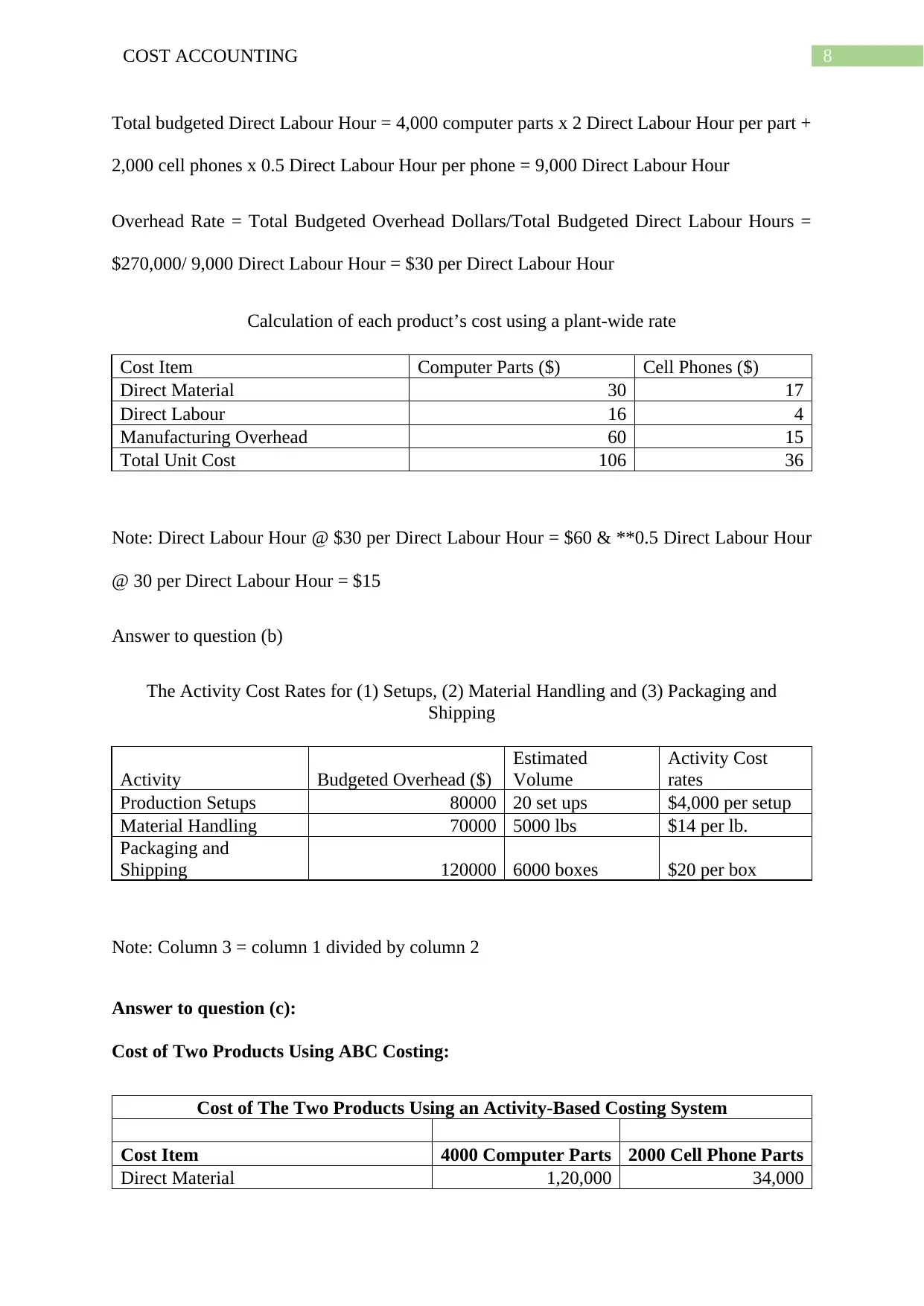
8COST ACCOUNTING
Total budgeted Direct Labour Hour = 4,000 computer parts x 2 Direct Labour Hour per part +
2,000 cell phones x 0.5 Direct Labour Hour per phone = 9,000 Direct Labour Hour
Overhead Rate = Total Budgeted Overhead Dollars/Total Budgeted Direct Labour Hours =
$270,000/ 9,000 Direct Labour Hour = $30 per Direct Labour Hour
Calculation of each product’s cost using a plant-wide rate
Cost Item Computer Parts ($) Cell Phones ($)
Direct Material 30 17
Direct Labour 16 4
Manufacturing Overhead 60 15
Total Unit Cost 106 36
Note: Direct Labour Hour @ $30 per Direct Labour Hour = $60 & **0.5 Direct Labour Hour
@ 30 per Direct Labour Hour = $15
Answer to question (b)
The Activity Cost Rates for (1) Setups, (2) Material Handling and (3) Packaging and
Shipping
Activity Budgeted Overhead ($)
Estimated
Volume
Activity Cost
rates
Production Setups 80000 20 set ups $4,000 per setup
Material Handling 70000 5000 lbs $14 per lb.
Packaging and
Shipping 120000 6000 boxes $20 per box
Note: Column 3 = column 1 divided by column 2
Answer to question (c):
Cost of Two Products Using ABC Costing:
Cost of The Two Products Using an Activity-Based Costing System
Cost Item 4000 Computer Parts 2000 Cell Phone Parts
Direct Material 1,20,000 34,000
Total budgeted Direct Labour Hour = 4,000 computer parts x 2 Direct Labour Hour per part +
2,000 cell phones x 0.5 Direct Labour Hour per phone = 9,000 Direct Labour Hour
Overhead Rate = Total Budgeted Overhead Dollars/Total Budgeted Direct Labour Hours =
$270,000/ 9,000 Direct Labour Hour = $30 per Direct Labour Hour
Calculation of each product’s cost using a plant-wide rate
Cost Item Computer Parts ($) Cell Phones ($)
Direct Material 30 17
Direct Labour 16 4
Manufacturing Overhead 60 15
Total Unit Cost 106 36
Note: Direct Labour Hour @ $30 per Direct Labour Hour = $60 & **0.5 Direct Labour Hour
@ 30 per Direct Labour Hour = $15
Answer to question (b)
The Activity Cost Rates for (1) Setups, (2) Material Handling and (3) Packaging and
Shipping
Activity Budgeted Overhead ($)
Estimated
Volume
Activity Cost
rates
Production Setups 80000 20 set ups $4,000 per setup
Material Handling 70000 5000 lbs $14 per lb.
Packaging and
Shipping 120000 6000 boxes $20 per box
Note: Column 3 = column 1 divided by column 2
Answer to question (c):
Cost of Two Products Using ABC Costing:
Cost of The Two Products Using an Activity-Based Costing System
Cost Item 4000 Computer Parts 2000 Cell Phone Parts
Direct Material 1,20,000 34,000
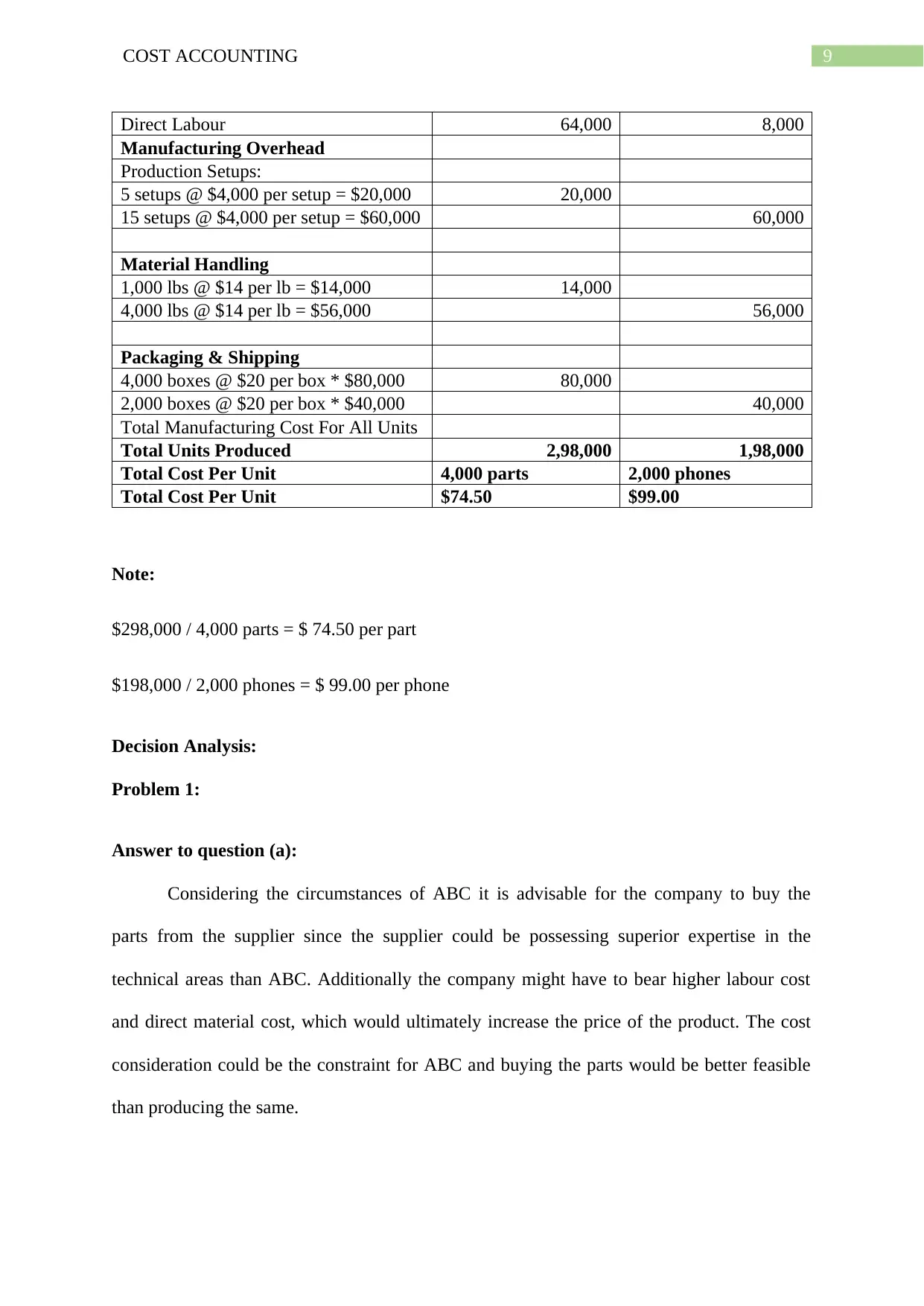
9COST ACCOUNTING
Direct Labour 64,000 8,000
Manufacturing Overhead
Production Setups:
5 setups @ $4,000 per setup = $20,000 20,000
15 setups @ $4,000 per setup = $60,000 60,000
Material Handling
1,000 lbs @ $14 per lb = $14,000 14,000
4,000 lbs @ $14 per lb = $56,000 56,000
Packaging & Shipping
4,000 boxes @ $20 per box * $80,000 80,000
2,000 boxes @ $20 per box * $40,000 40,000
Total Manufacturing Cost For All Units
Total Units Produced 2,98,000 1,98,000
Total Cost Per Unit 4,000 parts 2,000 phones
Total Cost Per Unit $74.50 $99.00
Note:
$298,000 / 4,000 parts = $ 74.50 per part
$198,000 / 2,000 phones = $ 99.00 per phone
Decision Analysis:
Problem 1:
Answer to question (a):
Considering the circumstances of ABC it is advisable for the company to buy the
parts from the supplier since the supplier could be possessing superior expertise in the
technical areas than ABC. Additionally the company might have to bear higher labour cost
and direct material cost, which would ultimately increase the price of the product. The cost
consideration could be the constraint for ABC and buying the parts would be better feasible
than producing the same.
Direct Labour 64,000 8,000
Manufacturing Overhead
Production Setups:
5 setups @ $4,000 per setup = $20,000 20,000
15 setups @ $4,000 per setup = $60,000 60,000
Material Handling
1,000 lbs @ $14 per lb = $14,000 14,000
4,000 lbs @ $14 per lb = $56,000 56,000
Packaging & Shipping
4,000 boxes @ $20 per box * $80,000 80,000
2,000 boxes @ $20 per box * $40,000 40,000
Total Manufacturing Cost For All Units
Total Units Produced 2,98,000 1,98,000
Total Cost Per Unit 4,000 parts 2,000 phones
Total Cost Per Unit $74.50 $99.00
Note:
$298,000 / 4,000 parts = $ 74.50 per part
$198,000 / 2,000 phones = $ 99.00 per phone
Decision Analysis:
Problem 1:
Answer to question (a):
Considering the circumstances of ABC it is advisable for the company to buy the
parts from the supplier since the supplier could be possessing superior expertise in the
technical areas than ABC. Additionally the company might have to bear higher labour cost
and direct material cost, which would ultimately increase the price of the product. The cost
consideration could be the constraint for ABC and buying the parts would be better feasible
than producing the same.
Secure Best Marks with AI Grader
Need help grading? Try our AI Grader for instant feedback on your assignments.
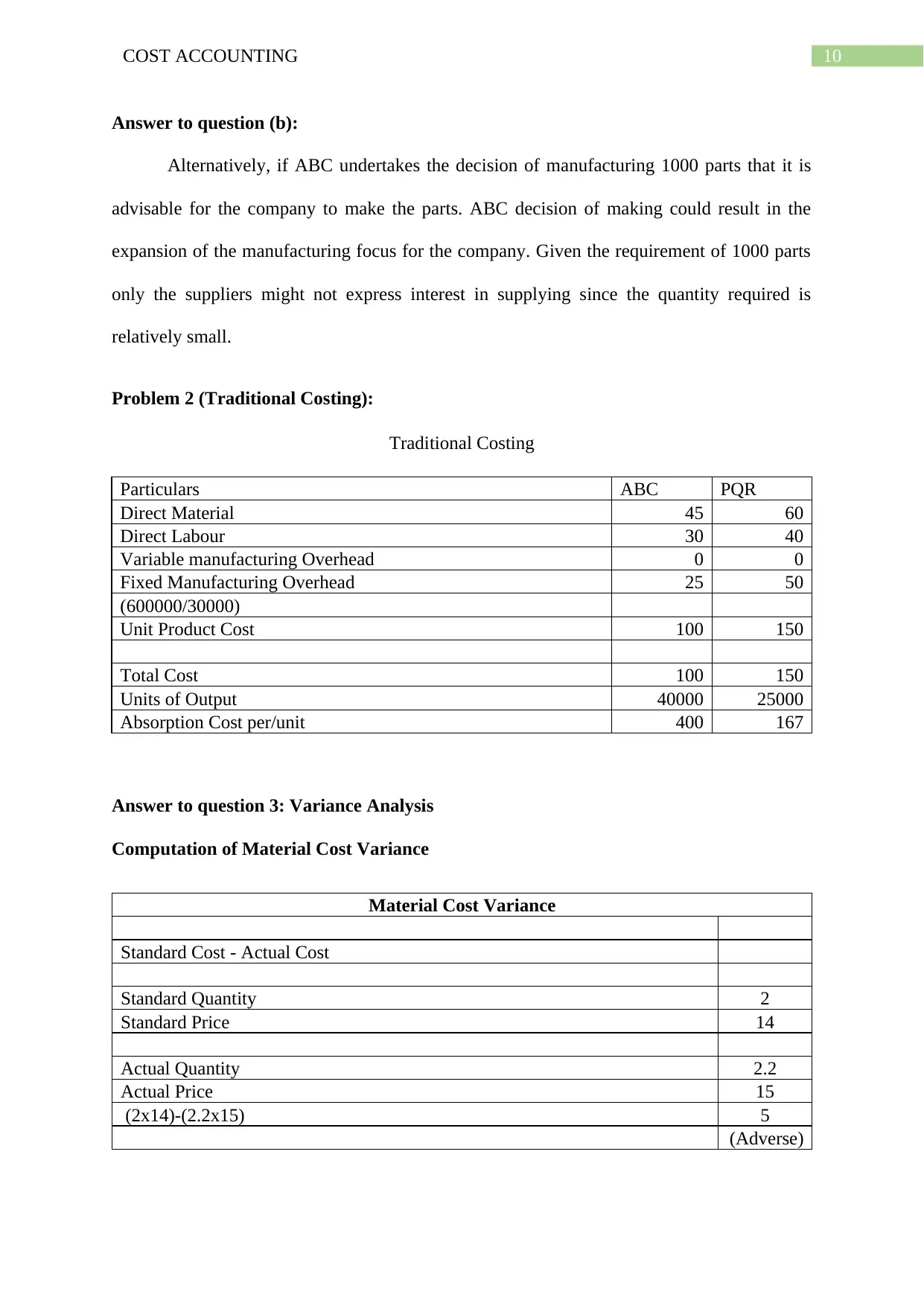
10COST ACCOUNTING
Answer to question (b):
Alternatively, if ABC undertakes the decision of manufacturing 1000 parts that it is
advisable for the company to make the parts. ABC decision of making could result in the
expansion of the manufacturing focus for the company. Given the requirement of 1000 parts
only the suppliers might not express interest in supplying since the quantity required is
relatively small.
Problem 2 (Traditional Costing):
Traditional Costing
Particulars ABC PQR
Direct Material 45 60
Direct Labour 30 40
Variable manufacturing Overhead 0 0
Fixed Manufacturing Overhead 25 50
(600000/30000)
Unit Product Cost 100 150
Total Cost 100 150
Units of Output 40000 25000
Absorption Cost per/unit 400 167
Answer to question 3: Variance Analysis
Computation of Material Cost Variance
Material Cost Variance
Standard Cost - Actual Cost
Standard Quantity 2
Standard Price 14
Actual Quantity 2.2
Actual Price 15
(2x14)-(2.2x15) 5
(Adverse)
Answer to question (b):
Alternatively, if ABC undertakes the decision of manufacturing 1000 parts that it is
advisable for the company to make the parts. ABC decision of making could result in the
expansion of the manufacturing focus for the company. Given the requirement of 1000 parts
only the suppliers might not express interest in supplying since the quantity required is
relatively small.
Problem 2 (Traditional Costing):
Traditional Costing
Particulars ABC PQR
Direct Material 45 60
Direct Labour 30 40
Variable manufacturing Overhead 0 0
Fixed Manufacturing Overhead 25 50
(600000/30000)
Unit Product Cost 100 150
Total Cost 100 150
Units of Output 40000 25000
Absorption Cost per/unit 400 167
Answer to question 3: Variance Analysis
Computation of Material Cost Variance
Material Cost Variance
Standard Cost - Actual Cost
Standard Quantity 2
Standard Price 14
Actual Quantity 2.2
Actual Price 15
(2x14)-(2.2x15) 5
(Adverse)
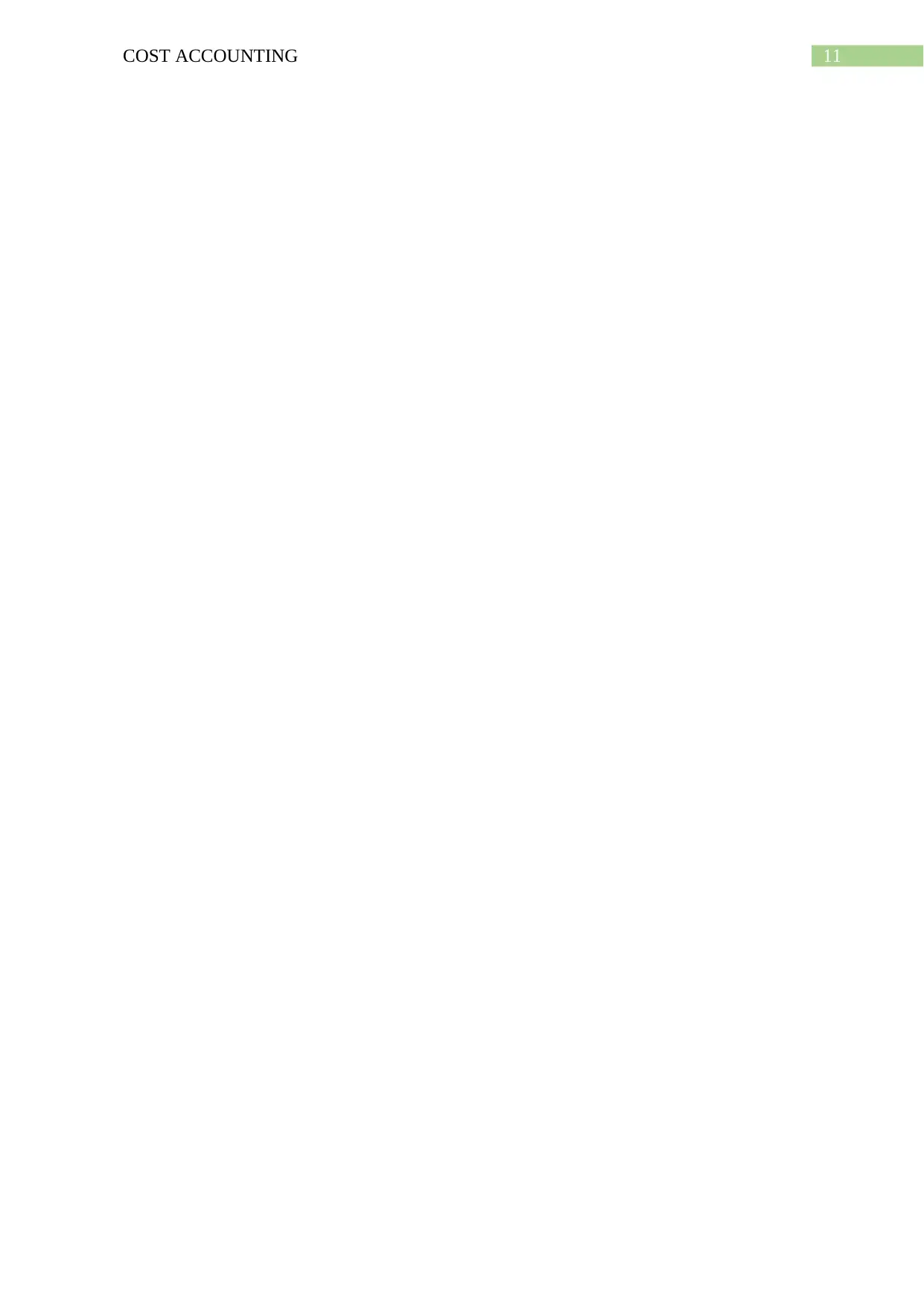
11COST ACCOUNTING
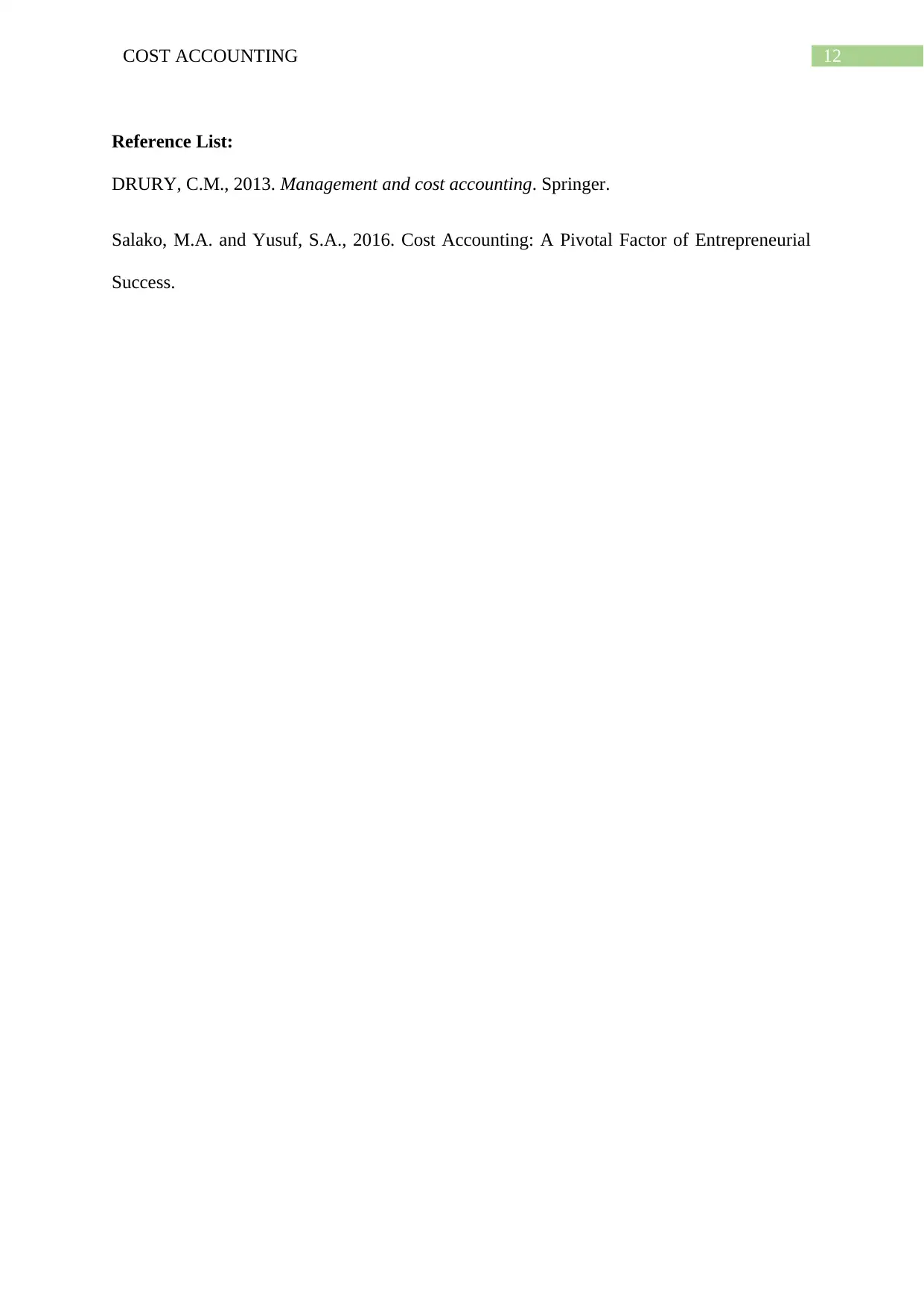
12COST ACCOUNTING
Reference List:
DRURY, C.M., 2013. Management and cost accounting. Springer.
Salako, M.A. and Yusuf, S.A., 2016. Cost Accounting: A Pivotal Factor of Entrepreneurial
Success.
Reference List:
DRURY, C.M., 2013. Management and cost accounting. Springer.
Salako, M.A. and Yusuf, S.A., 2016. Cost Accounting: A Pivotal Factor of Entrepreneurial
Success.
1 out of 13
Related Documents
Your All-in-One AI-Powered Toolkit for Academic Success.
+13062052269
info@desklib.com
Available 24*7 on WhatsApp / Email
![[object Object]](/_next/static/media/star-bottom.7253800d.svg)
Unlock your academic potential
© 2024 | Zucol Services PVT LTD | All rights reserved.





